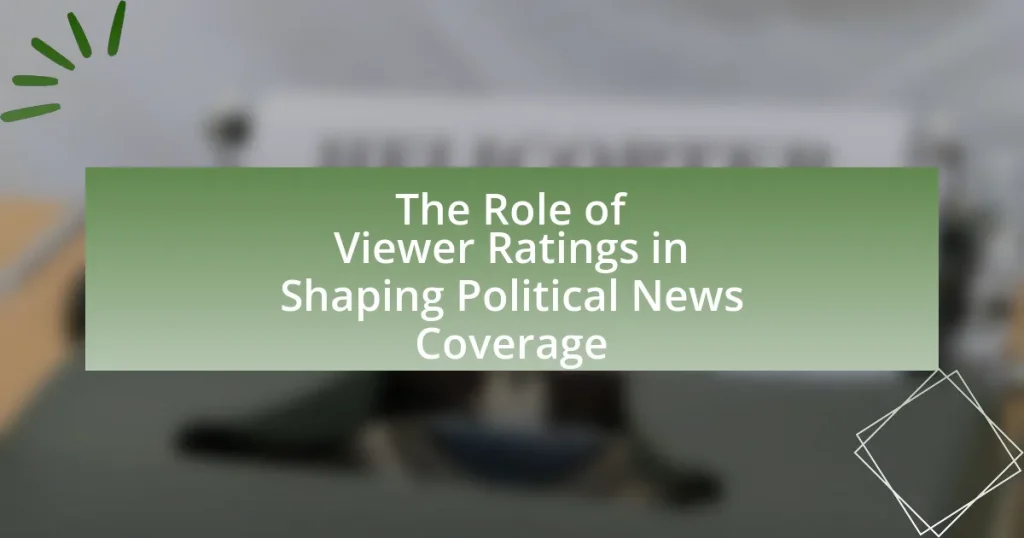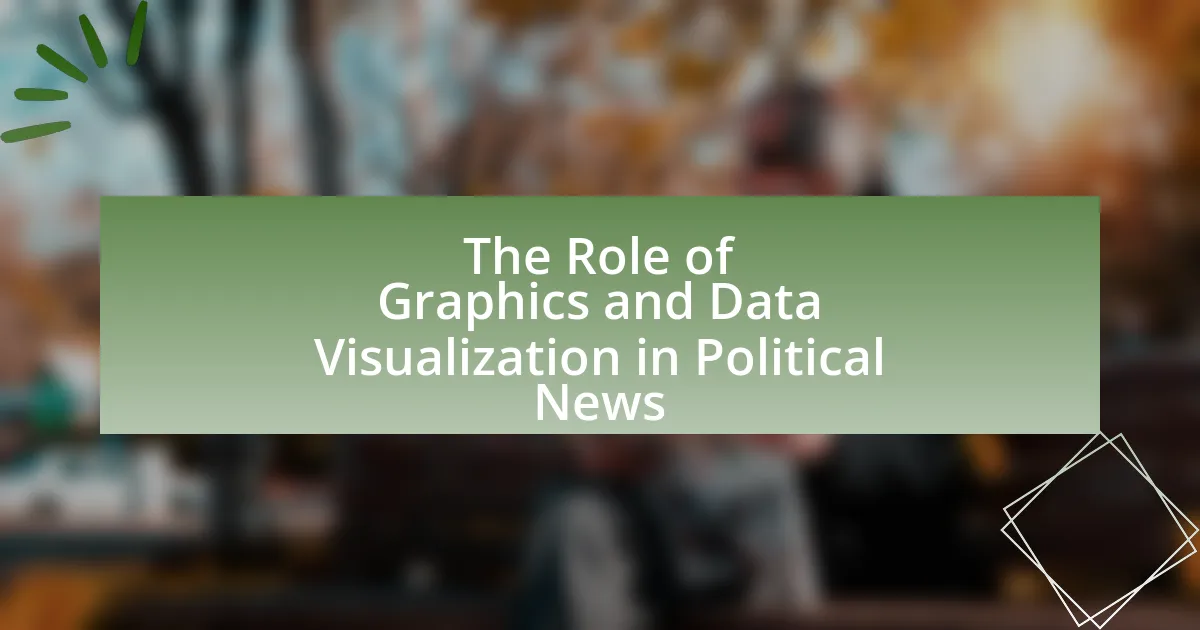The article examines the significant role of viewer ratings in shaping political news coverage. It highlights how news organizations prioritize stories based on audience engagement metrics, often leading to a focus on sensational or controversial topics that attract higher ratings. The piece discusses the implications of this trend on journalistic integrity, the diversity of political viewpoints, and the overall quality of political journalism. Additionally, it explores how audience demographics and advertiser interests further influence content selection, ultimately affecting public perception and discourse surrounding political issues.
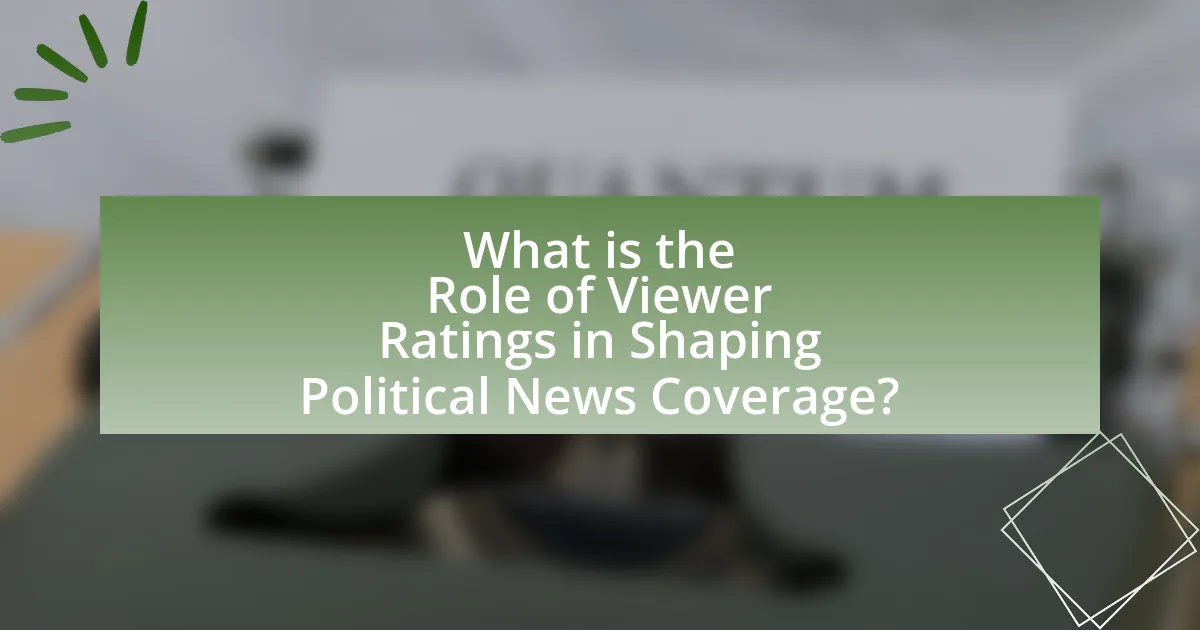
What is the Role of Viewer Ratings in Shaping Political News Coverage?
Viewer ratings significantly influence political news coverage by determining which stories are prioritized and how they are presented. News organizations often tailor their content to attract higher viewer engagement, leading to a focus on sensational or controversial topics that drive ratings. For instance, a study by the Pew Research Center found that news outlets frequently adjust their coverage based on audience preferences, which can result in a skewed representation of political events. This dynamic creates a feedback loop where high ratings reinforce certain narratives, shaping public perception and discourse around political issues.
How do viewer ratings influence the selection of political news stories?
Viewer ratings significantly influence the selection of political news stories by guiding news organizations on which topics to prioritize based on audience interest. High viewer ratings indicate a strong public demand for specific political content, prompting news outlets to focus on those stories to maintain or increase their audience share. For instance, studies have shown that news programs often feature stories with higher viewer engagement metrics, such as polls or election coverage, as these attract larger audiences and advertising revenue. This trend is evident in the way major networks allocate airtime to political events that resonate with viewers, thereby shaping the overall narrative and focus of political news coverage.
What metrics are used to measure viewer ratings in political news?
Viewer ratings in political news are primarily measured using metrics such as Nielsen ratings, audience share, and demographic breakdowns. Nielsen ratings quantify the number of viewers watching a program at a given time, providing a standard measure of viewership. Audience share indicates the percentage of the total viewing audience that is tuned into a specific program, reflecting its popularity relative to competing broadcasts. Demographic breakdowns analyze viewer characteristics, such as age, gender, and income, allowing networks to understand their audience better and tailor content accordingly. These metrics are essential for networks to gauge the effectiveness of their political news coverage and make strategic programming decisions.
How do news outlets interpret viewer ratings data?
News outlets interpret viewer ratings data as a critical indicator of audience engagement and preferences. They analyze these ratings to determine which topics resonate most with viewers, guiding editorial decisions and content strategies. For instance, higher ratings for political coverage often lead to increased investment in similar content, reflecting the audience’s interests. This interpretation is supported by studies showing that news programs with higher viewer ratings tend to focus more on sensational or controversial political issues, as these attract larger audiences and advertising revenue.
Why are viewer ratings significant in the context of political news?
Viewer ratings are significant in the context of political news because they directly influence the content and focus of news coverage. High viewer ratings indicate strong audience interest, prompting news organizations to prioritize certain political stories, issues, or candidates that resonate with viewers. For instance, a study by the Pew Research Center found that news outlets often tailor their reporting based on audience preferences, which can lead to a greater emphasis on sensational or polarizing political events that attract higher ratings. This dynamic shapes public discourse and can affect the political landscape by amplifying specific narratives while sidelining others.
What impact do viewer ratings have on journalistic integrity?
Viewer ratings significantly impact journalistic integrity by influencing editorial decisions and content prioritization. High ratings often lead news organizations to prioritize sensational or popular stories over critical but less engaging issues, potentially compromising the depth and accuracy of reporting. For instance, a study by the Pew Research Center found that news outlets frequently adjust their coverage based on audience preferences, which can result in a focus on entertainment rather than substantive political discourse. This shift can undermine the foundational principles of journalism, such as objectivity and accountability, as outlets may cater to viewer demands rather than uphold rigorous reporting standards.
How do viewer ratings affect the diversity of political viewpoints presented?
Viewer ratings significantly influence the diversity of political viewpoints presented in media. High viewer ratings often lead networks to prioritize content that appeals to the largest audience, which can result in a homogenization of political perspectives. For instance, studies have shown that news outlets may favor sensational or popular narratives over less mainstream viewpoints to maintain or increase their ratings, thereby limiting the representation of diverse political opinions. This trend is evident in the programming choices of major news networks, where content that aligns with the prevailing sentiments of their audience is more frequently aired, often sidelining alternative viewpoints.
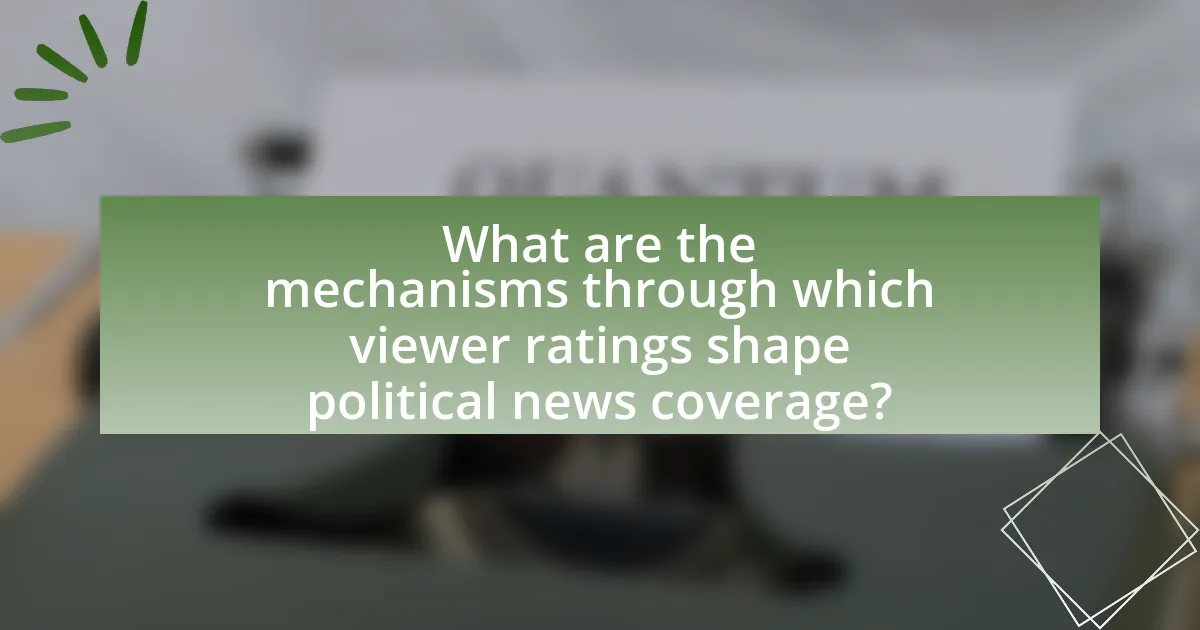
What are the mechanisms through which viewer ratings shape political news coverage?
Viewer ratings shape political news coverage primarily through audience-driven content selection and editorial decision-making. News organizations analyze viewer ratings to determine which political stories resonate most with audiences, leading to a focus on sensational or high-interest topics. For instance, a study by the Pew Research Center found that news outlets often prioritize coverage of events that attract higher viewership, such as elections or political scandals, over less sensational but equally important issues. This mechanism results in a feedback loop where high ratings reinforce the selection of similar content, ultimately influencing the political narratives presented to the public.
How do ratings drive editorial decisions in newsrooms?
Ratings significantly influence editorial decisions in newsrooms by determining which stories receive coverage and how they are presented. News organizations often prioritize content that garners higher viewer engagement, as evidenced by the fact that stories with higher ratings can lead to increased advertising revenue. For instance, a study by the Pew Research Center found that news outlets frequently adjust their programming based on audience metrics, leading to a focus on sensational or trending topics that attract more viewers. This reliance on ratings can result in a shift away from in-depth reporting on critical issues, as newsrooms cater to audience preferences rather than journalistic integrity.
What role do advertisers play in influencing news coverage based on viewer ratings?
Advertisers significantly influence news coverage by prioritizing content that attracts higher viewer ratings, which in turn drives advertising revenue. News organizations often tailor their reporting to align with the interests and preferences of their audience, as higher ratings lead to increased ad sales. For instance, a study by the Pew Research Center found that news outlets frequently adjust their programming to feature sensational or trending topics that are more likely to engage viewers, thereby enhancing their advertising appeal. This dynamic creates a feedback loop where advertisers’ demands for viewership metrics shape the editorial choices of news organizations, ultimately impacting the nature and focus of political news coverage.
How do audience demographics affect the type of political news covered?
Audience demographics significantly influence the type of political news covered by media outlets. News organizations tailor their content to align with the interests, values, and preferences of their target audience, which is often determined by demographic factors such as age, gender, ethnicity, and socioeconomic status. For instance, younger audiences may prefer coverage on social issues like climate change and technology, while older demographics might focus on traditional political topics such as healthcare and retirement policies.
Research indicates that media outlets that cater to specific demographic groups often see higher viewer ratings and engagement, which in turn drives advertising revenue. A study by the Pew Research Center found that 62% of Americans believe that news organizations should reflect the diversity of the population, suggesting that demographic considerations are crucial for maintaining audience relevance and loyalty. Thus, audience demographics directly shape the selection and framing of political news, ensuring that it resonates with the viewers’ identities and concerns.
What are the consequences of prioritizing viewer ratings in political news?
Prioritizing viewer ratings in political news leads to sensationalism and a focus on entertainment over informative content. This shift can result in the oversimplification of complex political issues, as news outlets may choose stories that attract higher ratings rather than those that provide in-depth analysis. For instance, a study by the Pew Research Center found that news organizations often prioritize stories that generate clicks and views, which can distort public understanding of critical political matters. Consequently, this trend can contribute to a less informed electorate, as viewers may receive a skewed perspective on important issues, ultimately affecting democratic processes.
How does the focus on ratings impact the quality of political journalism?
The focus on ratings negatively impacts the quality of political journalism by prioritizing sensationalism over factual reporting. This shift leads to the production of content designed to attract viewers rather than inform them, resulting in a decline in journalistic integrity. For instance, studies have shown that news outlets often emphasize dramatic narratives and conflict-driven stories to boost ratings, which can distort public understanding of complex political issues. According to a 2018 report by the Pew Research Center, 62% of Americans believe that news organizations prioritize ratings over accuracy, highlighting a widespread perception that the quality of political journalism suffers as a result.
What are the potential risks of sensationalism in political news driven by viewer ratings?
Sensationalism in political news driven by viewer ratings poses significant risks, including the distortion of public perception and the erosion of trust in media. When news outlets prioritize sensational stories to attract viewers, they often oversimplify complex political issues, leading to misinformation. For instance, a study by the Pew Research Center found that sensationalized reporting can contribute to polarized opinions among the public, as audiences may only engage with content that aligns with their biases. This creates an environment where critical thinking is undermined, and informed discourse is diminished, ultimately threatening the democratic process.
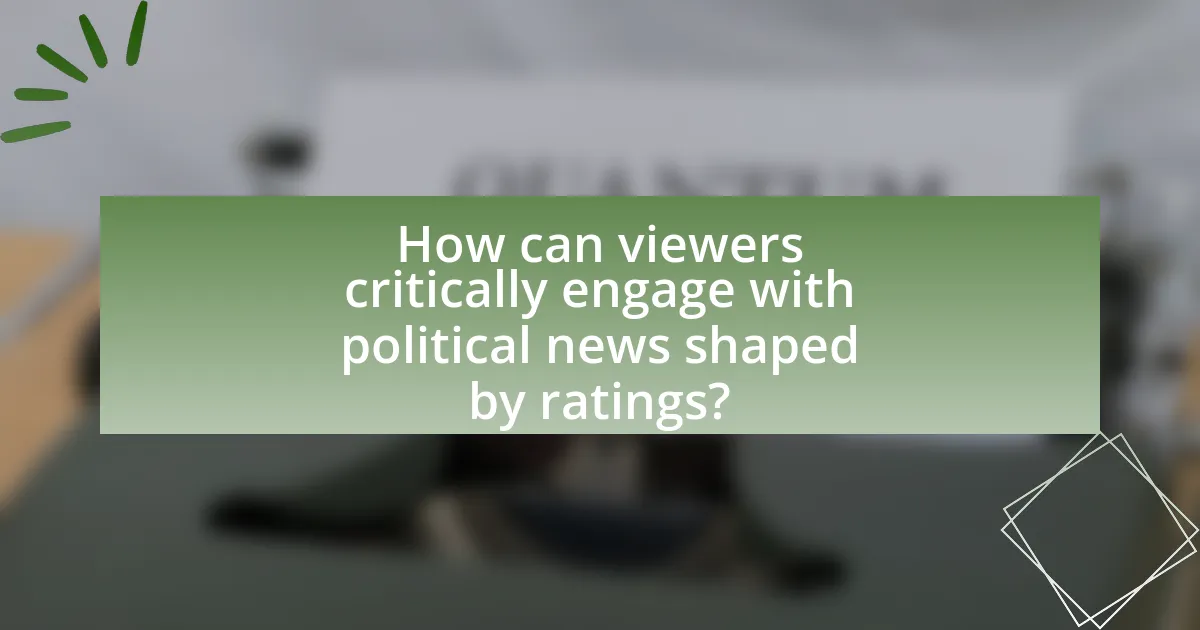
How can viewers critically engage with political news shaped by ratings?
Viewers can critically engage with political news shaped by ratings by actively analyzing the content for bias and sensationalism. This involves questioning the motivations behind the news coverage, as ratings often drive media outlets to prioritize stories that attract more viewers, potentially leading to a distortion of facts. Research indicates that sensationalized reporting can skew public perception, as seen in studies showing that emotionally charged headlines increase viewer engagement but may misrepresent the underlying issues. By cross-referencing multiple news sources and seeking out independent journalism, viewers can gain a more balanced understanding of political events, counteracting the influence of ratings-driven narratives.
What strategies can viewers use to assess the credibility of politically rated news?
Viewers can assess the credibility of politically rated news by cross-referencing information with multiple reputable sources. This strategy helps to identify discrepancies and verify facts, as credible news outlets typically adhere to journalistic standards and fact-checking protocols. For instance, a study by the Pew Research Center found that individuals who consume news from diverse sources are more likely to recognize misinformation. Additionally, viewers should evaluate the transparency of the news outlet regarding its funding, ownership, and potential biases, as these factors can influence reporting. Research indicates that media organizations with clear editorial guidelines and accountability measures tend to produce more reliable content.
How can viewers identify bias in political news influenced by ratings?
Viewers can identify bias in political news influenced by ratings by analyzing the language, framing, and selection of stories presented. Political news outlets often prioritize sensationalism or controversy to attract higher ratings, which can lead to skewed representations of events or issues. For instance, studies have shown that media outlets may emphasize negative aspects of a political figure or party to generate viewer engagement, as evidenced by research from the Pew Research Center indicating that emotionally charged content tends to receive more attention. Additionally, viewers should compare coverage across multiple sources to identify discrepancies in reporting, as consistent patterns of favoritism or negativity towards specific political entities can signal bias driven by ratings.
What resources are available for viewers to verify political news content?
Viewers can verify political news content using fact-checking websites, reputable news organizations, and academic resources. Fact-checking websites like Snopes, FactCheck.org, and PolitiFact provide thorough analyses of claims made in political news, often citing original sources and data. Reputable news organizations, such as BBC, Reuters, and Associated Press, adhere to journalistic standards and provide context and verification for their reporting. Academic resources, including peer-reviewed journals and studies from institutions like the Pew Research Center, offer data-driven insights into media coverage and political narratives, enhancing the viewer’s ability to discern factual information from misinformation.
How can viewers advocate for more balanced political news coverage?
Viewers can advocate for more balanced political news coverage by actively engaging with media outlets through feedback, social media, and petitions. By providing constructive criticism and expressing preferences for diverse perspectives, viewers can influence editorial decisions. Research indicates that audience feedback significantly impacts news programming choices, as media organizations often prioritize viewer ratings and engagement metrics to shape their content. For instance, a study by the Pew Research Center found that 62% of Americans believe news organizations should strive for balanced reporting, highlighting the demand for such coverage.
What actions can viewers take to support quality journalism over ratings-driven content?
Viewers can support quality journalism over ratings-driven content by subscribing to reputable news outlets that prioritize investigative reporting and factual accuracy. By financially backing these organizations, viewers help sustain their operations and encourage a focus on in-depth journalism rather than sensationalism. Research indicates that subscriptions to quality news sources, such as The New York Times or The Washington Post, have increased in recent years, reflecting a growing public demand for reliable information. Additionally, viewers can actively share and promote articles from these outlets on social media, amplifying their reach and impact. Engaging in discussions about the importance of quality journalism and advocating for media literacy in their communities further reinforces the value of substantive reporting over mere ratings.
How can community engagement influence the direction of political news coverage?
Community engagement can significantly influence the direction of political news coverage by shaping the topics that media outlets prioritize and report on. When communities actively participate in discussions, express concerns, or mobilize around specific issues, news organizations often respond by covering those topics more extensively to meet audience demand and maintain viewer interest. For instance, the rise of social media platforms has enabled grassroots movements to gain visibility, leading to increased coverage of issues like climate change and social justice, which may have previously been underreported. This shift is evidenced by the coverage of the Black Lives Matter movement, which gained substantial media attention due to widespread community engagement and protests, demonstrating how public sentiment can drive news narratives.
